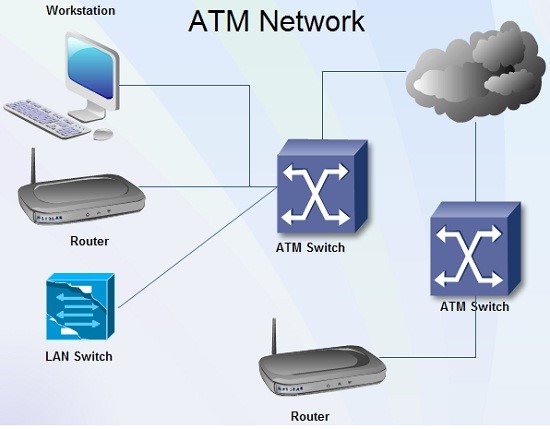ATM Network & How Does it Operate

An ATM (Asynchronous Transfer Mode) network is a high-speed networking standard designed to support the transmission of data, voice, and video. It uses a cell-based method of data transfer, meaning information is broken into small, fixed-size packets called cells. Here's an overview of what an ATM network is and how it operates:
Key Features of ATM Networks:
-
Cell-Based Transmission:
- Cells: Each cell in an ATM network is 53 bytes long, consisting of a 5-byte header and a 48-byte payload. The fixed size of the cells allows for predictable and efficient switching and transmission of data.
-
Asynchronous Transmission:
- Unlike synchronous systems that transmit data at regular intervals, ATM networks transmit cells as they are available. This means cells from different data streams can be interleaved, optimizing the use of network resources.
-
High-Speed and Low Latency:
- ATM is designed for high-speed data transfer with low latency, making it suitable for real-time applications like video conferencing and voice over IP (VoIP).
-
Quality of Service (QoS):
- ATM supports multiple QoS levels, which can prioritize different types of traffic. This ensures that time-sensitive data (like voice and video) is given priority over less sensitive data (like emails).
How ATM Networks Operate:
-
Connection-Oriented:
- ATM is a connection-oriented technology, meaning a virtual circuit (either permanent or switched) must be established between the sender and the receiver before data transmission can begin.
- Virtual Channel (VC): This is a logical connection between two network endpoints.
- Virtual Path (VP): This is a bundle of virtual channels that share the same path through the network.
-
Cell Relay:
- Data is segmented into 48-byte payloads and packaged into 53-byte cells.
- Each cell is transmitted independently and may take different paths to reach the destination.
-
Switching:
- ATM switches route cells based on the information in the cell header. The header contains details like the Virtual Path Identifier (VPI) and Virtual Channel Identifier (VCI) which are used to determine the next hop in the network.
- Switching is performed at hardware speed, which contributes to the low latency and high throughput of ATM networks.
-
Multiplexing:
- ATM allows for the multiplexing of different data streams over the same network. This is achieved through the use of VPI and VCI values that differentiate between different streams of data.
-
Traffic Management:
- ATM includes mechanisms for managing network traffic to avoid congestion and ensure QoS. This involves techniques like traffic shaping, policing, and scheduling.
Applications of ATM Networks:
- Telecommunications: ATM is often used in the backbone of telecom networks due to its ability to carry multiple types of traffic (voice, video, data).
- Internet Service Providers (ISPs): ISPs use ATM to manage data traffic efficiently and provide high-speed internet services.
- Corporate Networks: Large organizations use ATM networks for reliable and high-speed interconnectivity between various branch offices.
Advantages of ATM Networks:
- Scalability: Can handle a wide range of data rates.
- Flexibility: Supports a variety of applications and data types.
- Efficiency: Fixed cell size allows for efficient processing and switching.
Disadvantages of ATM Networks:
- Complexity: The technology is complex and can be costly to implement.
- Overhead: The fixed cell size can lead to inefficiency for small data transfers due to the relatively large header.
In summary, ATM networks are powerful and versatile, capable of handling various forms of data with high efficiency and low latency. They are particularly useful in scenarios requiring high QoS and reliable data transmission across large and complex networks.
Thank you,
